Examining the Book of Jeremiah 1
Mike Ervin
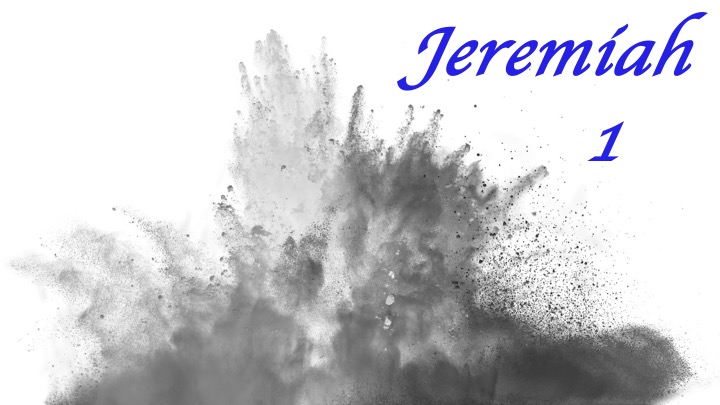
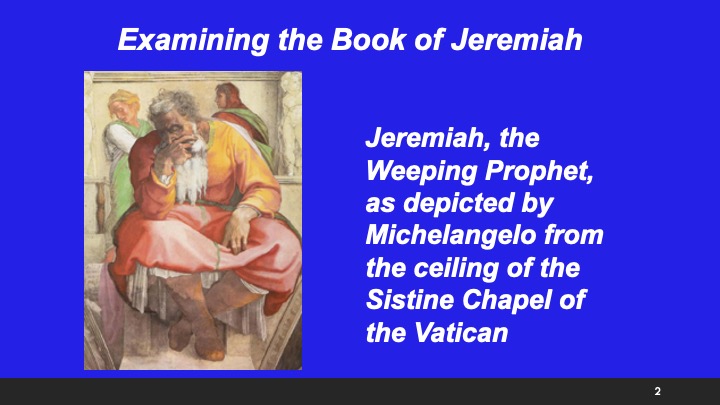
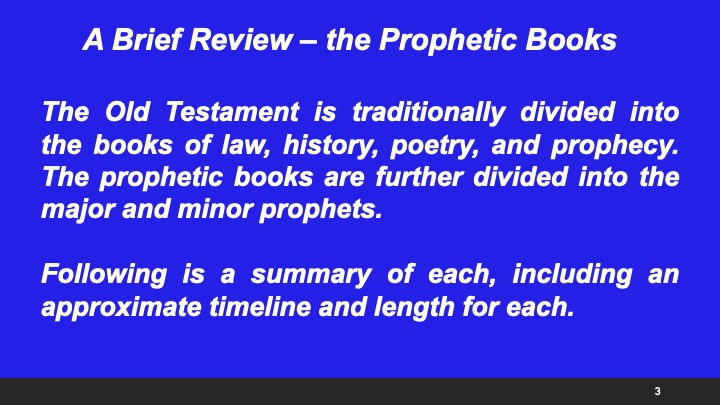
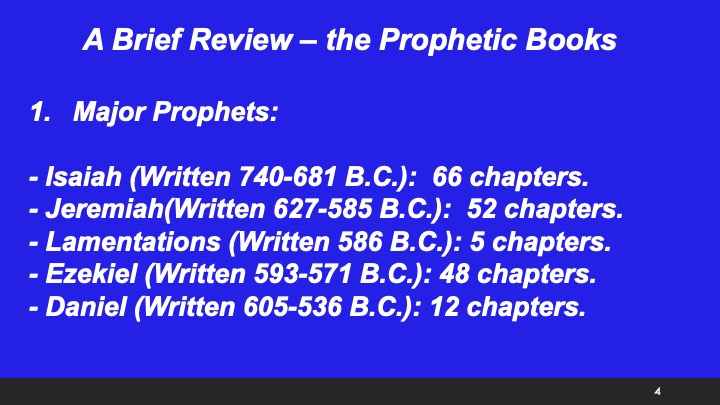
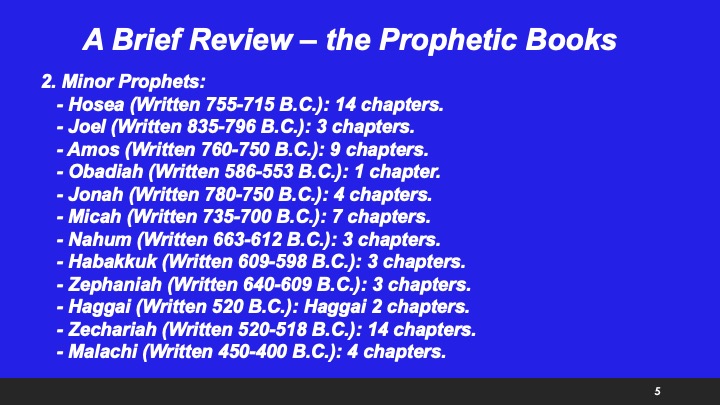
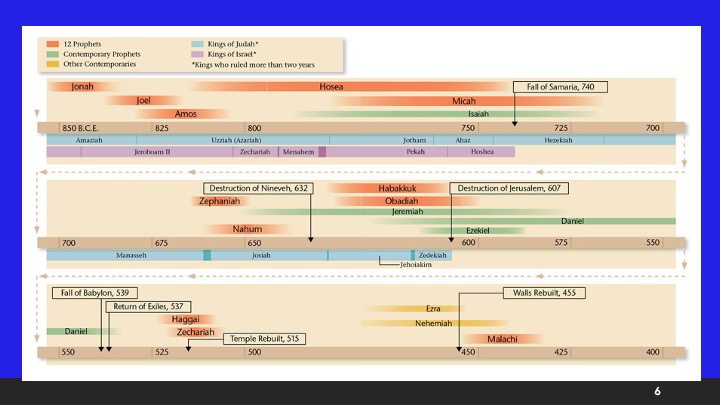
This slide is a rather comprehensive view of 450 years that comprises the age of the prophets of our old testament.
All of the prophets (major and minor) are shown (17 in total) beginning with Jonah in around 850 BC and extending to Malachi in about 440 BC. In addition, the Kings of the southern Kingdom of Israel are shown so that you know which Kings are being addressed by each of the prophets.
Key dates are also added. For example, the fall of Samaria (northern Kingdom) in 740 BC. The destruction of Nineveh (capitol of Assyria) in 632, the destruction of Jerusalem in 607, the fall of Babylon in 539, the return of the exiles in 537, the beginning of the second temple in 515, and the rebuilding of the walls of Jerusalem in 455.
All of these dates are supplied by the scholar that prepared it. It is important to note that all these dates are approximations. Different scholars have different dates. But this chart is very useful in understanding. You may not be able to read it today off this slide, but it will be on the Third Well website after this class and you can study it in detail at your leisure.
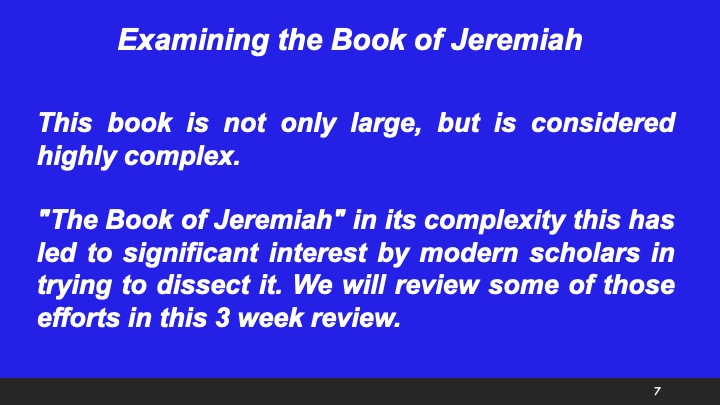
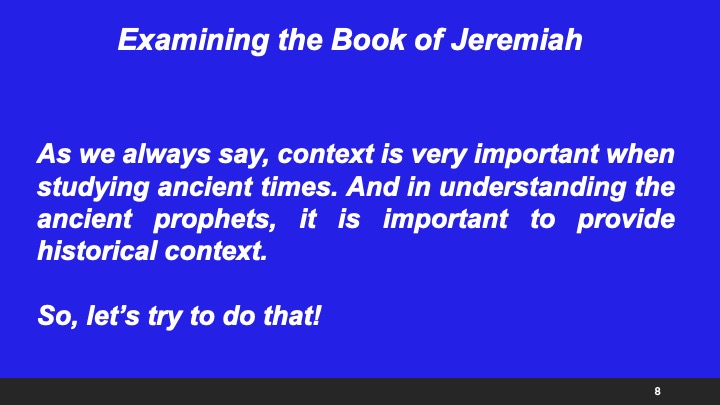
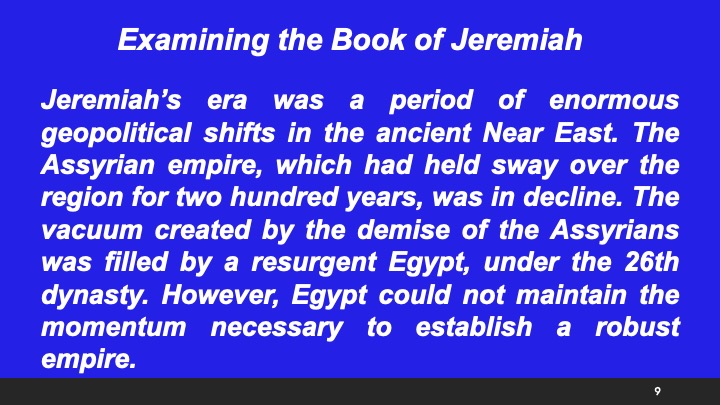
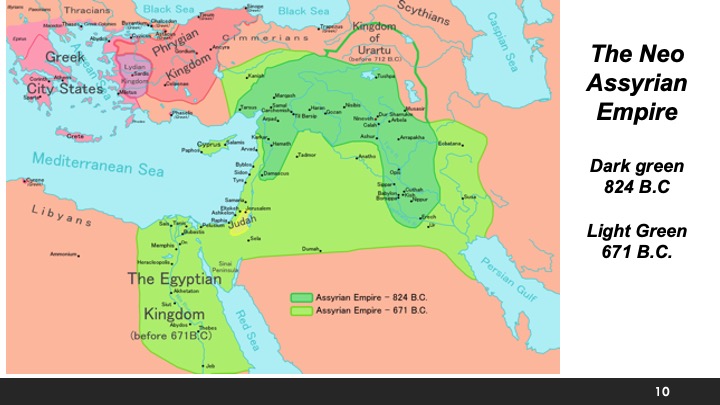
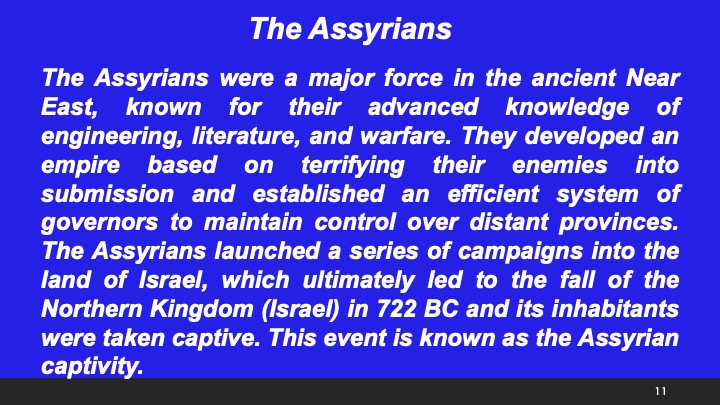
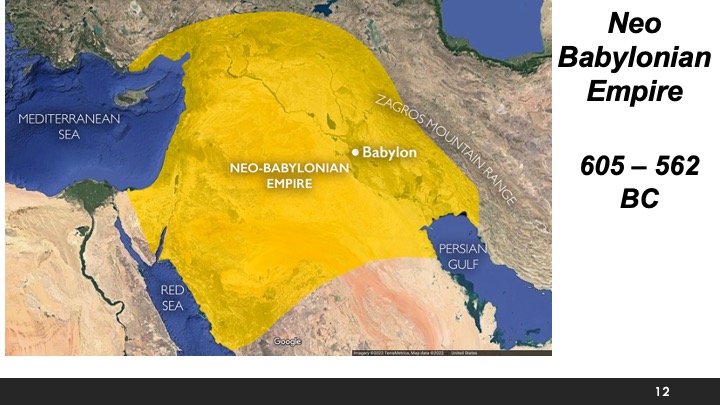
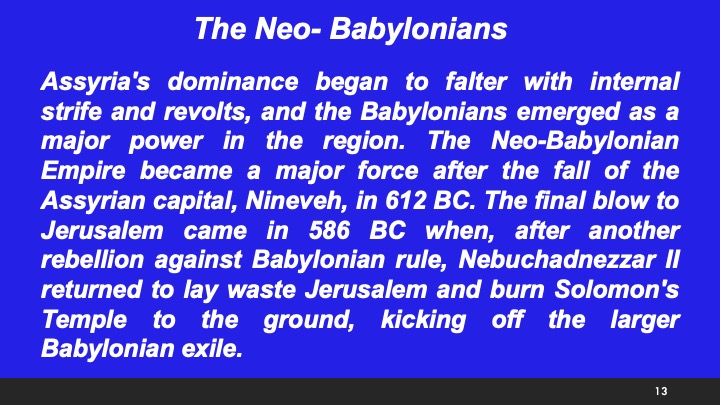
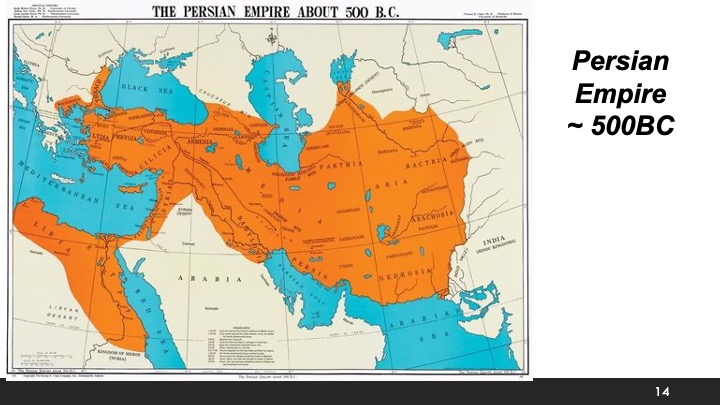
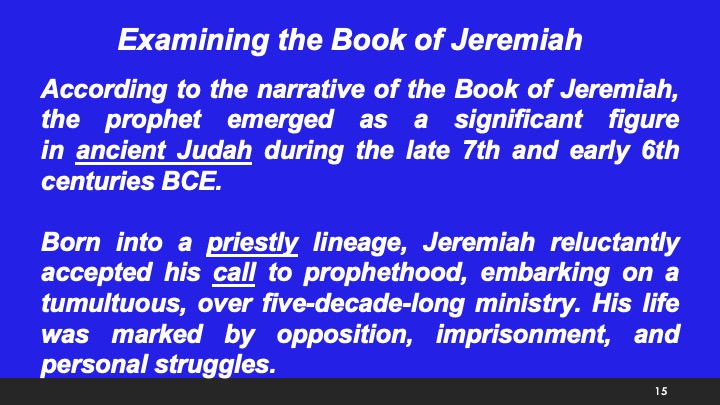
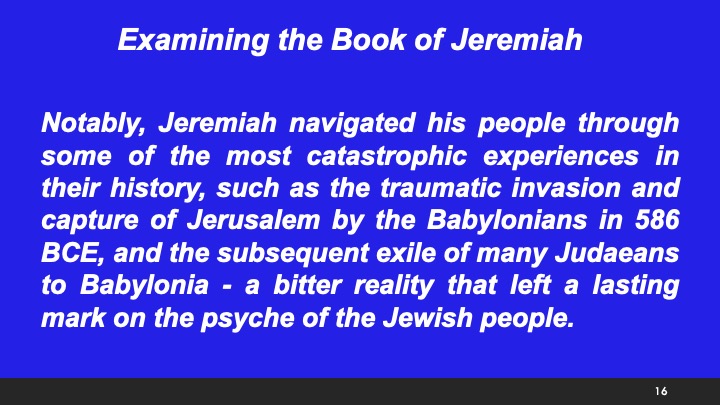
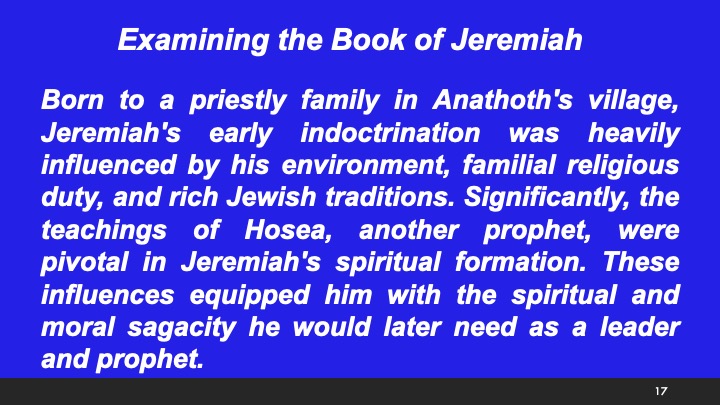
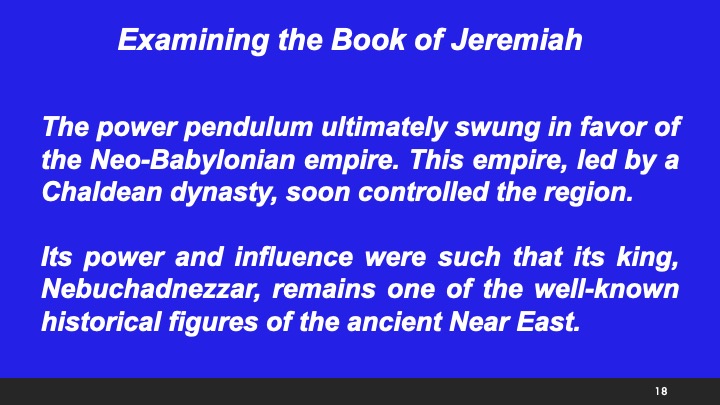
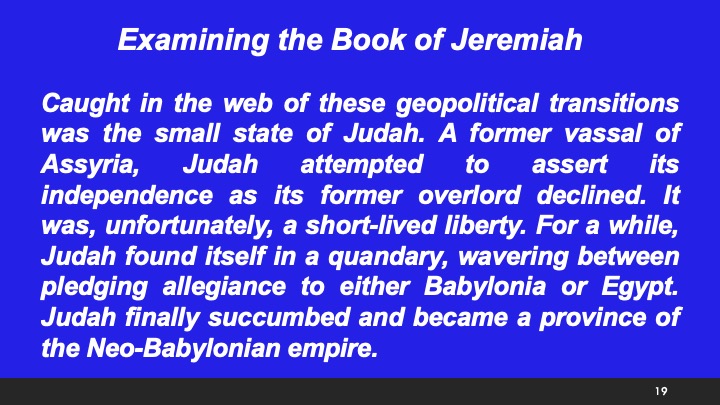
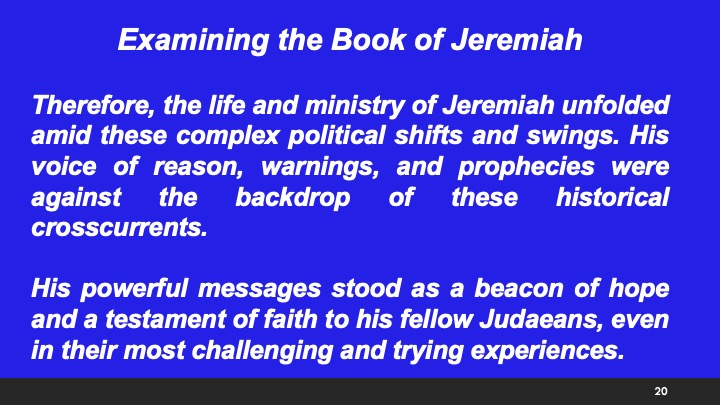
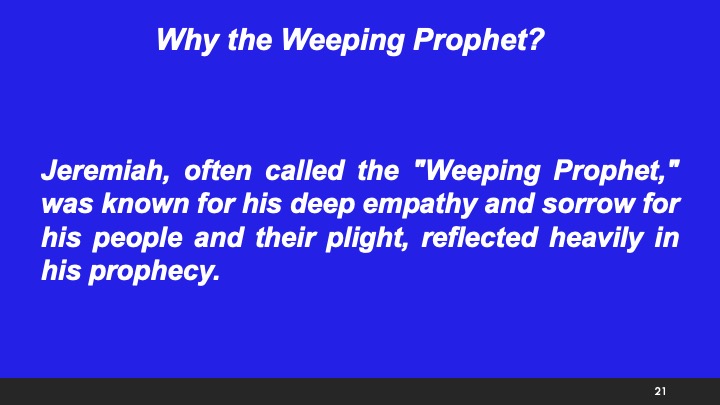
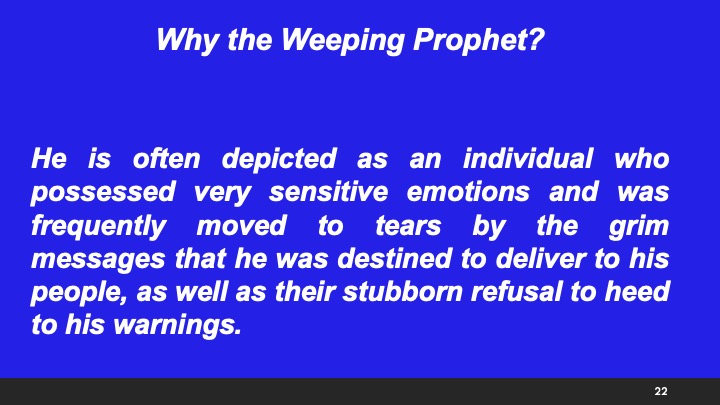
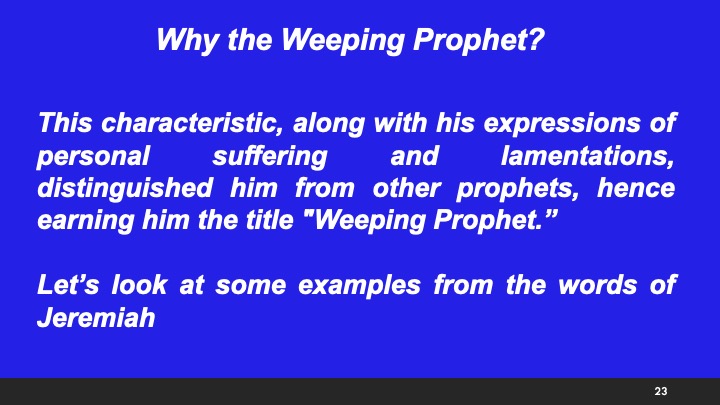
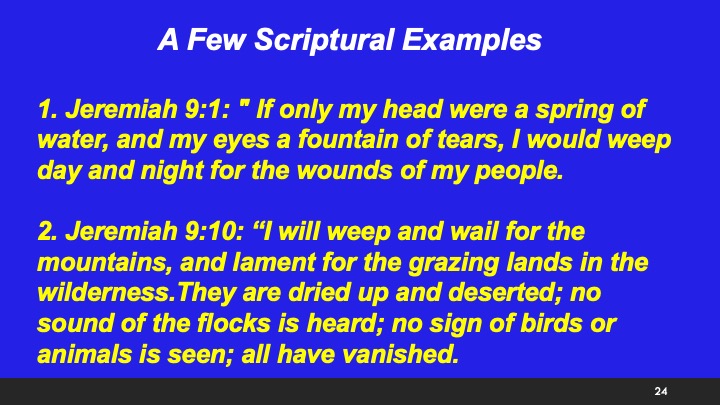
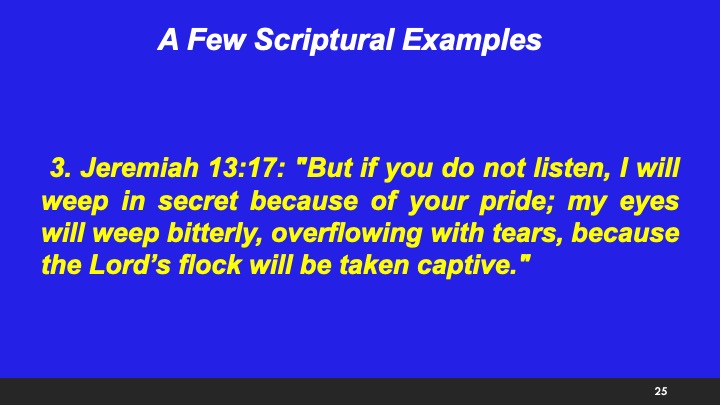
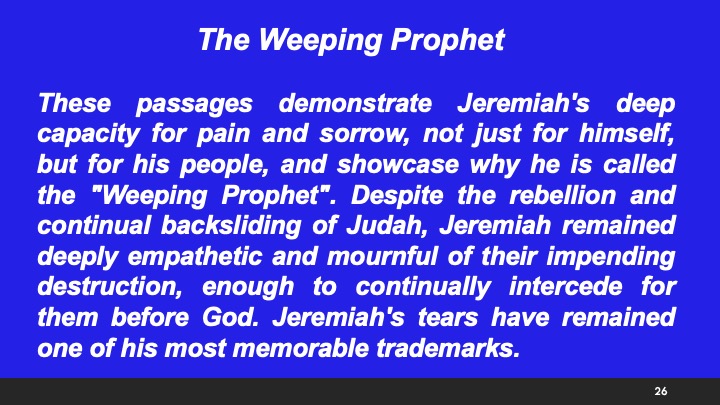
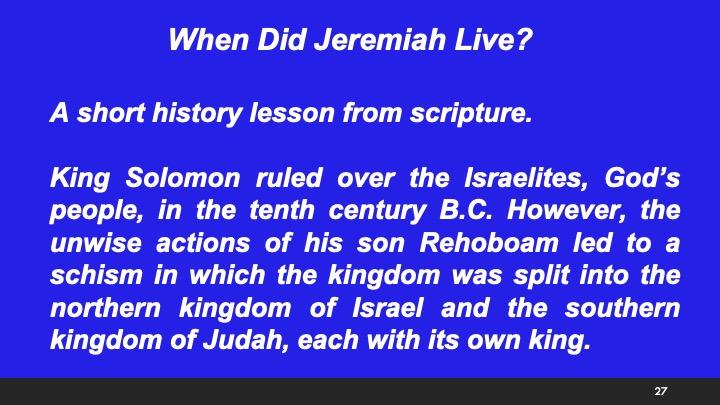
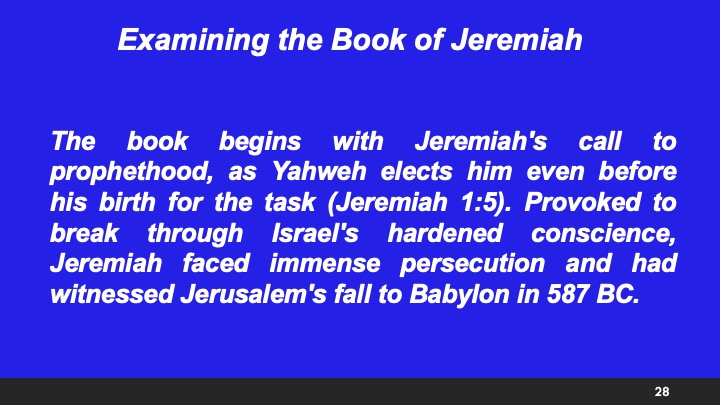
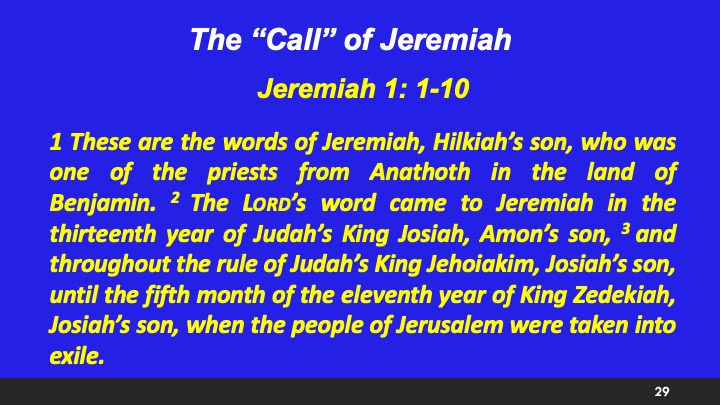
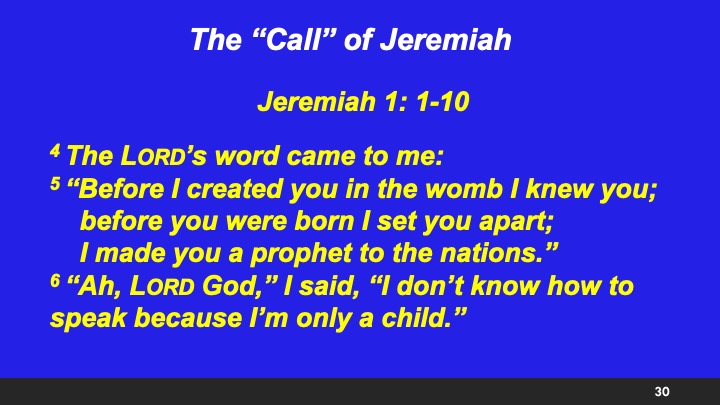
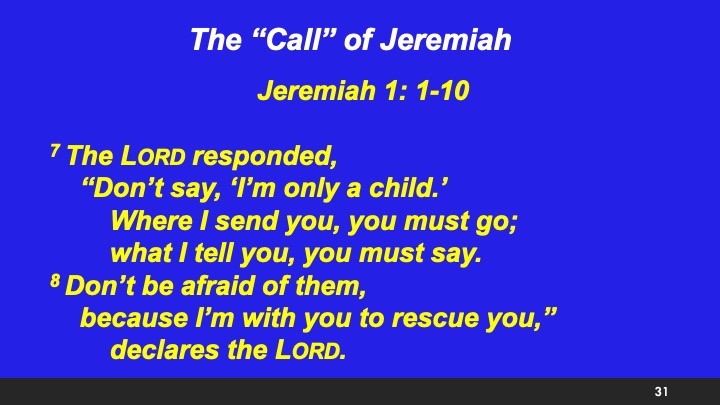
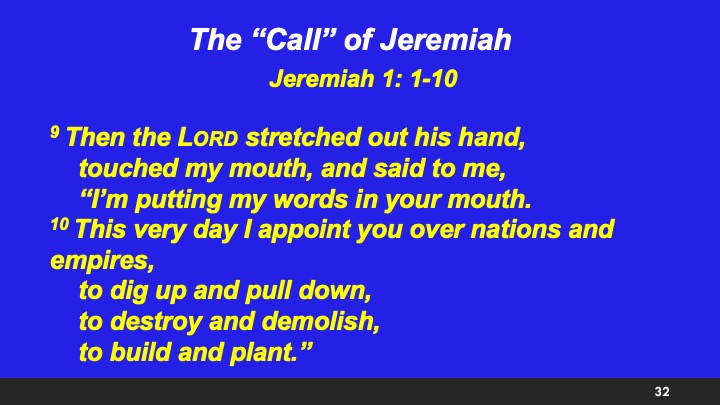
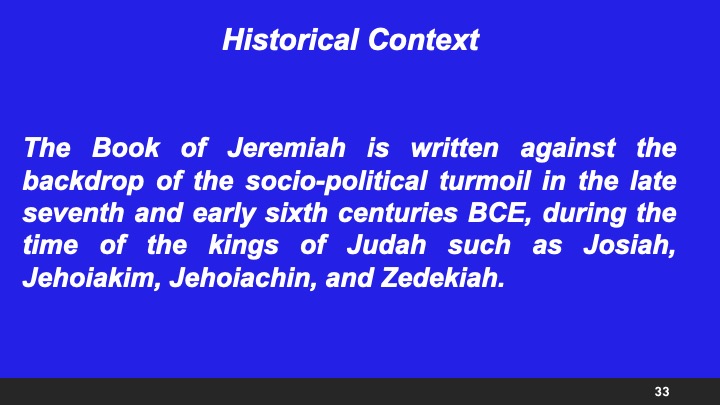
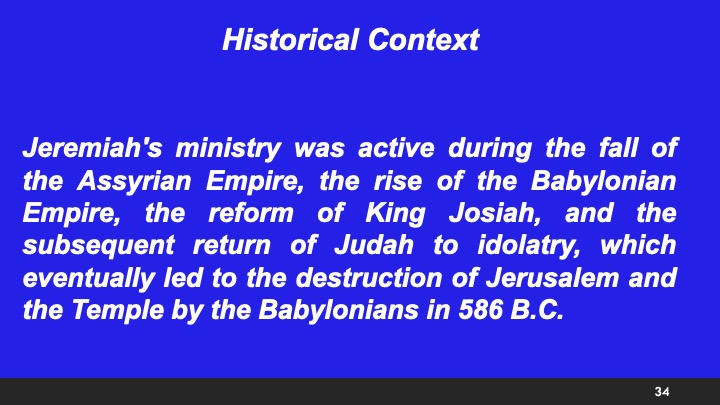
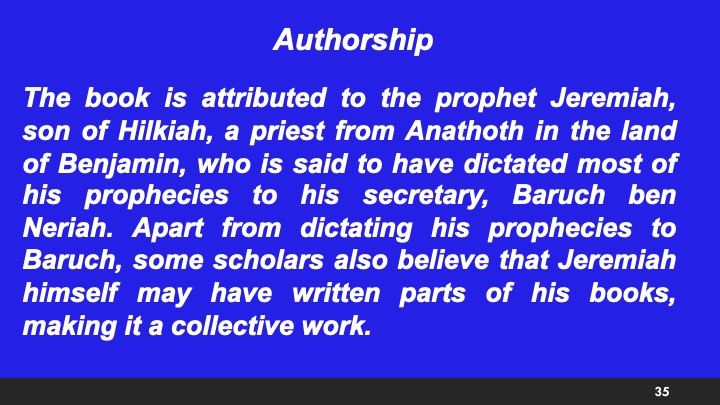
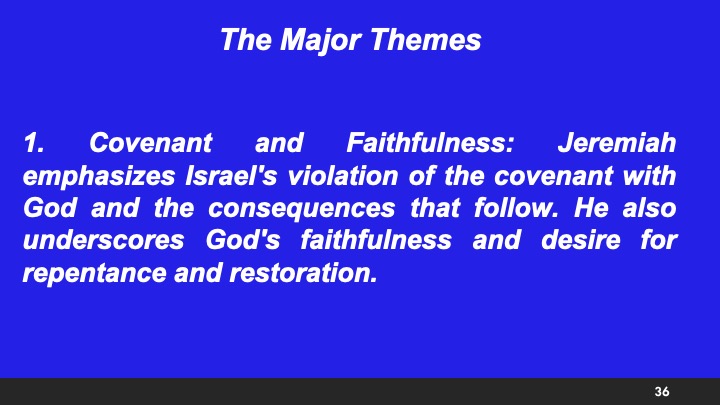
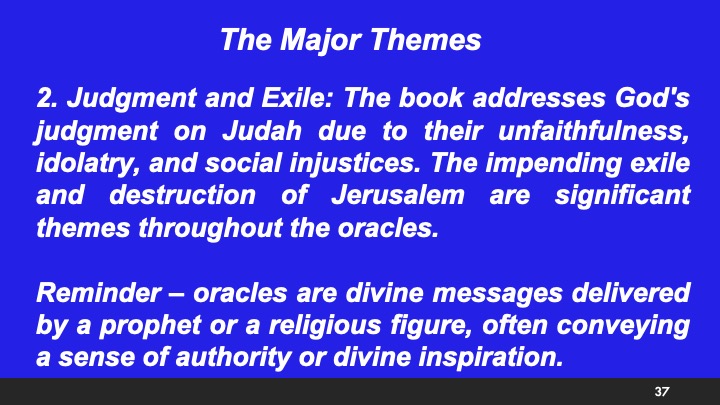
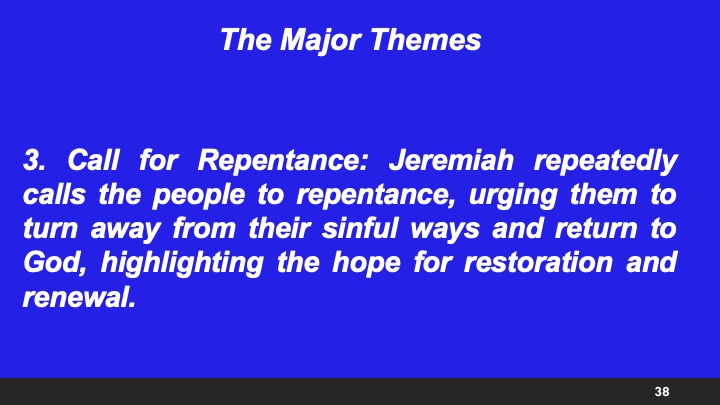
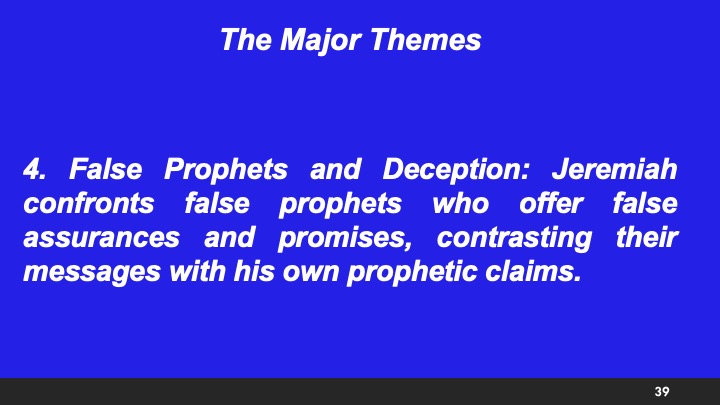
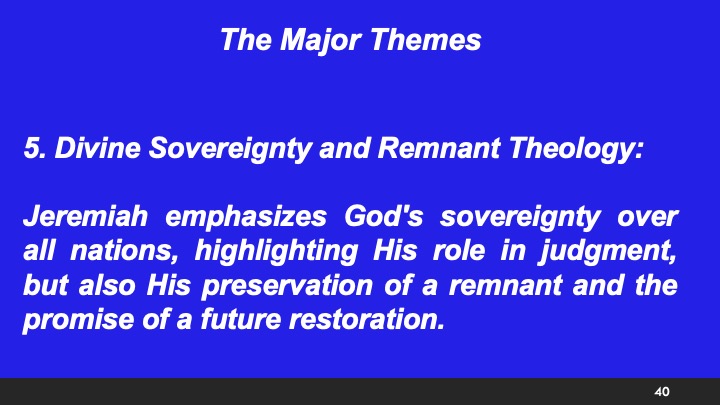
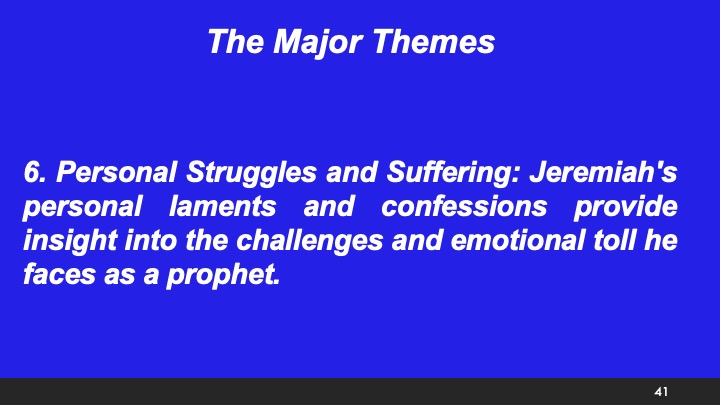
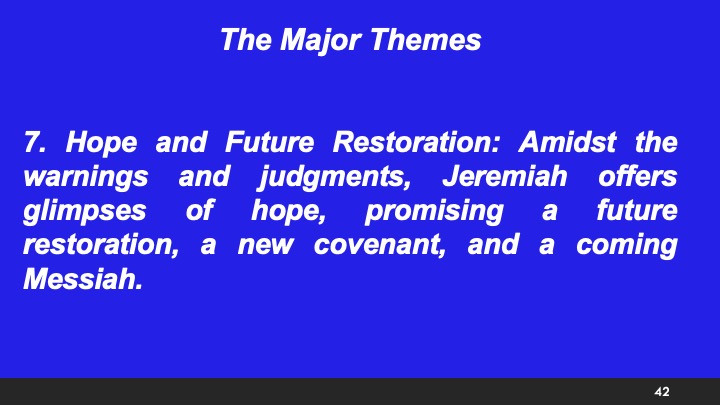
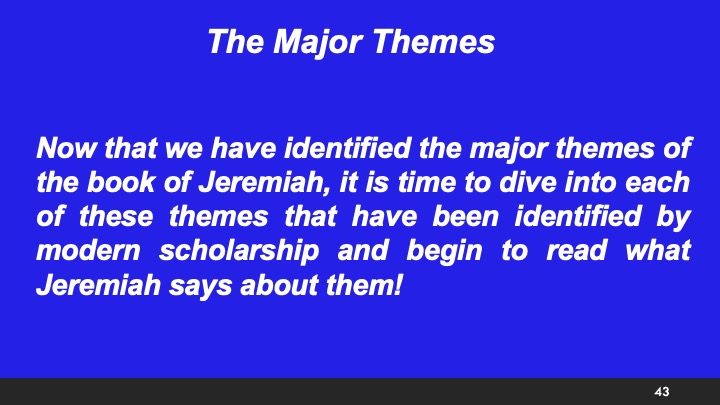
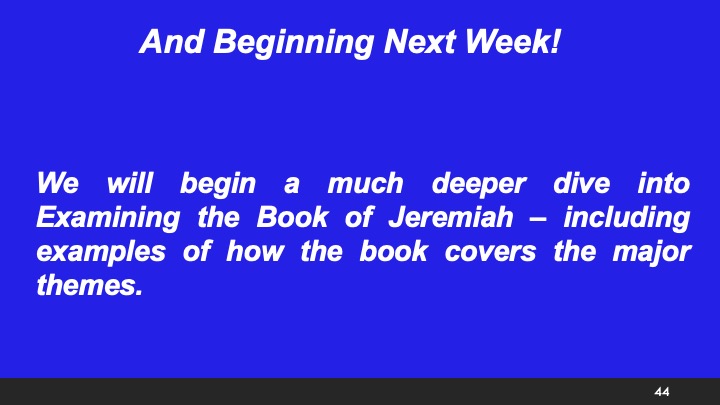

Examining the Book of Jeremiah 1
Links
< Home Page > < Examining Jeremiah Menu > < Top of Page >
And so, we now turn to the next major prophetic book of our Old Testament - the book of Jeremiah.
As you. may recall we voted last year to address some of the larger prophets of the old testament this year, and we have already covered Isaiah in December and the first two lessons of January.
Like the book of Isaiah, the book of Jeremiah is a a major prophet. We will talk a little more about which of the prophetic books were major vs. minor prophets. And the terms refer not to their relative importance but to their length. The minor prophets are found in our protestant bibles at the end of our old testament - the last 12 books. And they are significantly smaller in size.
Let’s first give some context to Examining the Book of Jeremiah. Jeremiah Is believed to have lived from (c. 650 – c. 570 BC. A life span of 80 years. And the way that most modern scholars estimate the dates of most of the prophets is based on which Kings of Judah they talked about in their books.
And later I will show you a timeline of his life as compared to the fairly well known historical events that happened to Judah.
Jeremiah was one of the major prophets of the Hebrew Bible. According to Jewish tradition, Jeremiah authored the Book of Jeremiah, the Books of Kings and the Book of Lamentations, with the assistance and under the editorship of Baruch ben Neriah, his personal scribe and disciple. And we are not sure how much of the elegant poetry of Jeremiah can be ascribed to Jeremiah himself, or to his very able scribe. You will learn more about Baruch ben Neriah as we go through these lessons.
Jeremiah has commonly been labeled "the weeping prophet”, which I will explain shortly.
Born to a priestly family in Anathoth's village, Jeremiah's early indoctrination was heavily influenced by his environment, familial religious duty, and rich Jewish traditions. Significantly, the teachings of Hosea, another prophet, were pivotal in Jeremiah's spiritual formation. These influences equipped him with the spiritual and moral sagacity he would later need as a leader and prophet.
The Old Testament is traditionally divided into the books of law, history, poetry, and prophecy. The prophetic books are further divided into the major and minor prophets. Here is a summary of each, including an approximate timeline and length for each.
1. Major Prophets:
- Isaiah (Written 740-681 B.C.): Isaiah is the longest prophetic book in the Old Testament, with 66 chapters.
- Jeremiah (Written 627-585 B.C.): Jeremiah is the second-longest prophetic book, with 52 chapters.
- Lamentations (Written 586 B.C.): Five chapters, traditionally attributed to Jeremiah.
- Ezekiel (Written 593-571 B.C.): Ezekiel is one of the longer prophetic books, with 48 chapters.
- Daniel (Written 605-536 B.C.): Daniel is a fairly lengthy book, with 12 chapters.
2. Minor Prophets:
- Hosea (Written 755-715 B.C.): Hosea is one of the longer minor prophetic books, with 14 chapters.
- Joel (Written 835-796 B.C.): Joel is a short book with only 3 chapters.
- Amos (Written 760-750 B.C.): Amos contains 9 chapters.
- Obadiah (Written 586-553 B.C.): Obadiah only 1 chapter.
- Jonah (Written 780-750 B.C.): Jonah contains 4 chapters.
- Micah (Written 735-700 B.C.): Micah contains 7 chapters.
- Nahum (Written 663-612 B.C.): Nahum contains 3 chapters.
- Habakkuk (Written 609-598 B.C.): Habakkuk contains 3 chapters.
- Zephaniah (Written 640-609 B.C.): Zephaniah contains 3 chapters.
- Haggai (Written 520 B.C.): Haggai contains 2 chapters.
- Zechariah (Written 520-518 B.C.): Zechariah contains 14 chapters.
- Malachi (Written 450-400 B.C.): Malachi contains 4 chapters.
Examining the Book of Jeremiah
This book is not only large, but is considered highly complex, and as a result difficult to read.. Much more so than other books.
That complexity is due in part by the fact it is presented in a highly non-chronological way. An unusual aspect of the book that has puzzled scholars a great deal. We will review some examples of that that aspect later as we progress.
"The Book of Jeremiah" in its complexity this has led to significant interest by modern scholars in trying to dissect it. We will review some of those efforts in this 3 week review.
As we always say, context is very important when studying ancient times. And in understanding the ancient prophets, it is important to provide historical context.
So, let’s try to do that!
Jeremiah’s era was a period of enormous geopolitical shifts in the ancient Near East. The Assyrian empire, which had held sway over the region for two hundred years, was in decline. The vacuum created by the demise of the Assyrians was filled by a resurgent Egypt, under the 26th dynasty. However, Egypt could not maintain the momentum necessary to establish a robust empire.
Nourished by the Tigris and Euphrates Rivers, the cities of Mesopotamia—Greek for “the land between two rivers”—flourished from the 20th century to the end of the seventh century B.C.E. As the Assyrians created and expanded their empire, their political reach came to encompass—at its zenith around 680 B.C.E.—the Fertile Crescent, Egypt, central Anatolia, and western Iran.
Assyrian Empire (911-609 BC): The Neo-Assyrian Empire is usually considered to have begun with the reign of Adad-nirari II in 911 BC.
The Assyrians were a major force in the ancient Near East, known for their advanced knowledge of engineering, literature, and warfare. They developed an empire based on terrifying their enemies into submission and established an efficient system of governors to maintain control over distant provinces. The Assyrians launched a series of campaigns into the land of Israel, which ultimately led to the fall of the Northern Kingdom (Israel) in 722 BC and its inhabitants were taken captive. This event is known as the Assyrian captivity.
The Babylonians rose to power in the late 7th century and were heirs of the urban traditions which had long existed in southern Mesopotamia. They eventually ruled an empire as dominant in the Near East as that held by the Assyrians before them.
This period is called Neo-Babylonian (or new Babylonia) because Babylon had also risen to power earlier and became an independent city-state, most famously during the reign of King Hammurabi.
The Neo- Babylonians
Assyria's dominance began to falter with internal strife and revolts, and the Babylonians emerged as a major power in the region. The Neo-Babylonian Empire became a major force after the fall of the Assyrian capital, Nineveh, in 612 BC. The final blow to Jerusalem came in 586 BC when, after another rebellion against Babylonian rule, Nebuchadnezzar II returned to lay waste Jerusalem and burn Solomon's Temple to the ground, kicking off the Babylonian exile of the people of Judah.
The Babylonians rose to power in the late 7th century and were heirs of the urban traditions which had long existed in southern Mesopotamia. They eventually ruled an empire as dominant in the Near East as that held by the Assyrians before them.
Persian Empire ~ 500BC
The long background history of the Medes and the Persians is not well understood and seems to possibly go back for more than 2000 years. But eventually a new king Cyrus II moved into power and took power from the Medes and in about 550 BC it became the Persian Empire.
Cyrus II– a remarkable leader, quickly made short work of the faltering Neo- Babylon empire and thus quickly established a large Persian empire over all of of the ancient near east, including all of Egypt.
And to make a long story short he then allowed the Neo-Babylonian captives from Jerusalem to return to Judea and begin the reconstruction of the city and the eventual Second temple.
According to the narrative of the Book of Jeremiah, the prophet emerged as a significant figure in ancient Judah during the late 7th and early 6th centuries BCE.
Born into a priestly lineage, Jeremiah reluctantly accepted his call to prophethood, embarking on a tumultuous, over five-decade-long ministry. His life was marked by opposition, imprisonment, and personal struggles. Many of which led to his being called the weeping prophet.
As we tried to describe when covering Isaiah – being a prophet was a very dangerous business.
Notably, Jeremiah navigated his people through some of the most catastrophic experiences in their history, such as the traumatic invasion and capture of Jerusalem by the Babylonians in 586 BCE, and the subsequent exile of many Judaeans to Babylonia - a bitter reality that left a lasting mark on the psyche of the Jewish people.
Examining the Book of Jeremiah
Born to a priestly family in Anathoth's village, Jeremiah's early indoctrination was heavily influenced by his environment, familial religious duty, and rich Jewish traditions. Significantly, the teachings of Hosea, another prophet, were pivotal in Jeremiah's spiritual formation. These influences equipped him with the spiritual and moral sagacity he would later need as a leader and prophet.
The power pendulum ultimately swung in favor of the Neo-Babylonian empire. This empire, led by a Chaldean dynasty, soon controlled the region.
Its power and influence were such that its king, Nebuchadnezzar, remains one of the well-known historical figures of the ancient Near East.
Caught in the web of these geopolitical transitions was the small state of Judah. A former vassal of Assyria, Judah attempted to assert its independence as its former overlord declined. It was, unfortunately, a short-lived liberty. For a while, Judah found itself in a quandary, wavering between pledging allegiance to either Babylonia or Egypt. Judah finally succumbed and became a province of the Neo-Babylonian empire.
Therefore, the life and ministry of Jeremiah unfolded amid these complex political shifts and swings. His voice of reason, warnings, and prophecies were against the backdrop of these historical crosscurrents.
His powerful messages stood as a beacon of hope and a testament of faith to his fellow Judaeans, even in their most challenging and trying experiences.
Why the Weeping Prophet?
Why the weeping prophet?
Jeremiah, often called the "Weeping Prophet," was known for his deep empathy and sorrow for his people and their plight, reflected heavily in his prophecy.
He is often depicted as an individual who possessed very sensitive emotions and was frequently moved to tears by the grim messages that he was destined to deliver to his people, as well as their stubborn refusal to heed to his warnings.
This characteristic, along with his expressions of personal suffering and lamentations, distinguished him from other prophets, hence earning him the title "Weeping Prophet.”
Let’s look at some examples from the words of Jeremiah
A Few Scriptural Examples
1. Jeremiah 9:1: " If only my head were a spring of water, and my eyes a fountain of tears, I would weep day and night for the wounds of my people.
2. Jeremiah 9:10: “I will weep and wail for the mountains, and lament for the grazing lands in the wilderness.They are dried up and deserted; no sound of the flocks is heard; no sign of birds or animals is seen; all have vanished.
3. Jeremiah 13:17: "But if you do not listen, I will weep in secret because of your pride; my eyes will weep bitterly, overflowing with tears, because the Lord’s flock will be taken captive."
These passages demonstrate Jeremiah's deep capacity for pain and sorrow, not just for himself, but for his people, and showcase why he is called the "Weeping Prophet". Despite the rebellion and continual backsliding of Judah, Jeremiah remained deeply empathetic and mournful of their impending destruction, enough to continually intercede for them before God. Jeremiah's tears have remained one of his most memorable trademarks.
When Did Jeremiah Live?
It’s important to know the context of Jeremiah’s time in order to understand his life. Part of this requires a partial overview of the history of the Israelites in the Promised Land.
Let’s begin that overview by starting in the time of King Solomon. King Solomon ruled over the Israelites, God’s people, in the tenth century B.C. However, the unwise actions of his son Rehoboam led to a schism in which the kingdom was split into the northern kingdom of Israel and the southern kingdom of Judah, each with its own king.
Examining the Book of Jeremiah
So where do we begin? Well, as usual we will start at the beginning
The book begins with Jeremiah's call to prophethood, as Yahweh elects him even before his birth for the task (Jeremiah 1:5). Provoked to break through Israel's hardened conscience, Jeremiah faced immense persecution and had witnessed Jerusalem's fall to Babylon in 587 BC. That may be why he wept so much.
The “Call” of Jeremiah
Jeremiah 1: 1-10
1 These are the words of Jeremiah, Hilkiah’s son, who was one of the priests from Anathoth in the land of Benjamin. 2 The Lord’s word came to Jeremiah in the thirteenth year of Judah’s King Josiah, Amon’s son, 3 and throughout the rule of Judah’s King Jehoiakim, Josiah’s son, until the fifth month of the eleventh year of King Zedekiah, Josiah’s son, when the people of Jerusalem were taken into exile.
4 The Lord’s word came to me:
5 “Before I created you in the womb I
knew you;
before you were born I set you apart;
I made you a prophet to the nations.”
6 “Ah, Lord God,” I said, “I don’t know how to speak
because I’m only a child.”
7 The Lord responded,
“Don’t say, ‘I’m only a child.’
Where I send you, you must go;
what I tell you, you must say.
8 Don’t be afraid of them,
because I’m with you to rescue you,”
declares the Lord.
9 Then the Lord stretched
out his hand,
touched my mouth, and said to me,
“I’m putting my words in your mouth.
10 This very day I appoint you over nations and empires,
to dig up and pull down,
to destroy and demolish,
to build and plant.”
Historical Context
The Book of Jeremiah is written against the backdrop of the socio-political turmoil in the late seventh and early sixth centuries BCE, during the time of the kings of Judah such as Josiah, Jehoiakim, Jehoiachin, and Zedekiah.
Jeremiah's ministry was active during the fall of the Assyrian Empire, the rise of the Babylonian Empire, the reform of King Josiah, and the subsequent return of Judah to idolatry, which eventually led to the destruction of Jerusalem and the Temple by the Babylonians in 586 B.C.
Authorship
The book is attributed to the prophet Jeremiah, son of Hilkiah, a priest from Anathoth in the land of Benjamin, who is said to have dictated most of his prophecies to his secretary, Baruch ben Neriah. Apart from dictating his prophecies to Baruch, some scholars also believe that Jeremiah himself may have written parts of his books, making it a collective work.
The Major Themes
1. Covenant and Faithfulness: Jeremiah emphasizes Israel's violation of the covenant with God and the consequences that follow. He also underscores God's faithfulness and desire for repentance and restoration.
2. Judgment and Exile: The book addresses God's judgment on Judah due to their unfaithfulness, idolatry, and social injustices. The impending exile and destruction of Jerusalem are significant themes throughout the oracles. Reminder – oracles are divine messages delivered by a prophet or a religious figure, often conveying a sense of authority or divine inspiration.
3. Call for Repentance: Jeremiah repeatedly calls the people to repentance, urging them to turn away from their sinful ways and return to God, highlighting the hope for restoration and renewal.
4. False Prophets and Deception: Jeremiah confronts false prophets who offer false assurances and promises, contrasting their messages with his own prophetic claims.
5. Divine Sovereignty and Remnant Theology: Jeremiah emphasizes God's sovereignty over all nations, highlighting His role in judgment, but also His preservation of a remnant and the promise of a future restoration.
6. Personal Struggles and Suffering: Jeremiah's personal laments and confessions provide insight into the challenges and emotional toll he faces as a prophet.
7. Hope and Future Restoration: Amidst the warnings and judgments, Jeremiah offers glimpses of hope, promising a future restoration, a new covenant, and a coming Messiah.
The Major Themes
Now that we have identified the major themes of the book of Jeremiah, it is time to dive into each of these themes that have been identified by modern scholarship and begin to read what Jeremiah says about them!
And Beginning Next Week!
We will begin a much deeper dive into Examining the Book of Jeremiah – including examples of how the book covers the major themes.
And this becomes the End of Today’s show of Examining the Book of Jeremiah.
But next week we will do a much deeper dive into the major themes we just reviewed.
And this becomes the End of Today’s show of Examining the Book of Jeremiah.
But next week we will do a much deeper dive into the major themes we just reviewed.